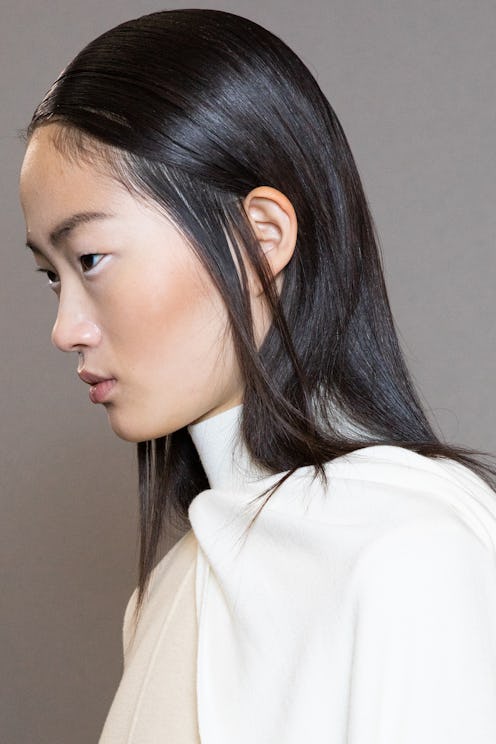(Hair)
The Real Difference Between Ceramic & Titanium Flat Irons Is This
"If not used properly, they can cause serious damage to the hair."

The path towards silky, shiny hair is often ignited by smoke — literally. A common problem when it comes to flat-ironing hair — especially curlier textures — is overheating it by turning your tool up to 450 degrees. A huge hairstylist no-no. Instead, some experts indicate that the problem might lie in the plates of the tool you're using. There's a slight difference between ceramic flat irons and titanium flat irons, which is part of the reason why your finished look isn't always the straightest.
The major difference between the two plates is the rate and method by which it heats the hair. Ceramic plates heat the hair from the inside out, while titanium heats from the surface of the hair shaft. You might notice that your ceramic flat iron takes longer to heat up. And in the long run, that may be a good thing.
While titanium flat irons heat up almost immediately, the risks for your hair are higher. "Titanium flat irons are great for professional use," says Cheryl Bergamy, editorial hairstylist. "While titanium flat irons provide a quick heat-up time and conduct heat evenly throughout the iron for a wonderful smoothening result, if not used properly, they can cause serious damage to the hair."
Another distinction is the method by which the plates heat the hair. Ceramic flat irons transmit heat through infrared technology, straightening the hair from the inside out which is generally more gentle, especially for finer textures. Titanium, however, heats the surface of the hair shaft.
How To Use A Flat Iron Safely
Regardless, if you prefer titanium or ceramic, many stylists agree that the most important factor is making sure that hair is properly prepped and protected, and keeping the flat iron heat to 375 degrees max. "Keeping hair protected through the straightening process all starts in the shower," Laura Polko, celebrity hairstylist and Nature Lab Tokyo ambassador, tells TZR. "If I know I am heat styling it’s important to use a hydrating shampoo and conditioner and, if needed, a treatment masque that will help restore hair and moisture so it’s ready for the heat you’re about to use on it."
And Bergamy has adopted a similar philosophy. "I apply a leave-in conditioning cream that is excellent for heat protection," she says. "Depending on how coarse or tight the curl pattern is, I may have my client sit with a plastic cap for a few minutes just to help infuse the moisture into the hair. I found that using this method makes the hair softer and easy to blow out without the risk of pulling, which can cause breakages. Lastly, if the hair needs it, I apply heat protecting oil before flat ironing."
And, when it's time for straightening, be sure to use a light hand. Titanium plates are notably much lighter than that of ceramic, creating the illusion that more passes are required to achieve a proper straightening. When used properly, however, titanium can be a quicker and more effective option, especially if you seek out a straightener with a heat sensor to prevent overheating.
Which Flat Iron Is Better For Curls?
It comes as no surprise that Bergamy prefers ceramic plates for natural hair. "It’s safer and you can control the heat temperature," she says. "Remember, we don’t want to ruin the curl pattern, so I recommend a ceramic and ionic duo flat iron. This flat iron is excellent for Infusing moisture into the hair while straightening."
And while she insists that a higher temperature is needed for an adequate straightening, not using too many passes is essential to maintaining the curl pattern. "I like to aim for 325 to 375 degrees depending on the coarseness of the hair," Bergamy says. "Be mindful on the temperature you use and how often you use it. When you overuse any iron, you can run the tendency to damage the elasticity of your hair causing your curl pattern to loosen over time."
Should You Use A Ceramic Or Titanium Flat Iron?
Aesthetics also plays a role in stylists selecting the type of straightener to use. "I’m a huge fan of ceramic," Polko says. "The plates leave hair super smooth and shiny and are not harsh on the hair." Bergamy, however, prefers the adversary. "Actually, I sometimes gravitate towards the titanium flat iron," she says. "Its beautiful silver exterior and light weight handle gives off such a glamorous look."
But she insists that before picking any straightener, she assesses the client's hair. "Often people get confused when trying to choose which flat iron would be best for their hair texture," Bergamy says. "As a hairstylist, each flat iron has its own uniqueness. I have a love affair with both titanium and ceramic, but if I had to choose which one to suggest for non-professional use, it would be the ceramic. Reason being, I’m all about safety, especially when it comes to styling textured hair."
We only include products that have been independently selected by The Zoe Report's editorial team. However, we may receive a portion of sales if you purchase a product through a link in this article.
Ceramic Flat Irons
Titanium Flat Irons
This article was originally published on